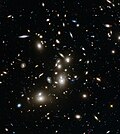| Abell 2744 | |
|---|---|
 Abell 2744, nicknamed Pandora's Cluster. The galaxies in the cluster make up less than five percent of its mass. The gas (around 20 percent) is so hot that it shines only in X-rays (coloured red in this image). The distribution of invisible dark matter (making up around 75 percent of the cluster's mass) is coloured here in blue. | |
| Observation data (Epoch J2000) | |
| Constellation | Sculptor |
| Right ascension | 00h 14m 19.51s [1] |
| Declination | −30° 23′ 19.18″ [1] |
| Richness class | 3 [2] |
| Bautz–Morgan classification | III [2] |
| Redshift | 0.30800 [3] |
| Distance | 1,221 Mpc (3,982 Mly) h−1 0.705 [3] |
| X-ray flux | (5.805 ± 4.7%)×10−13 erg s−1 cm−2 (0.1–2.4 keV) [3] |
| Other designations | |
| Pandora's Cluster | |
Abell 2744, nicknamed Pandora's Cluster, is a giant galaxy cluster resulting from the simultaneous pile-up of at least four separate, smaller galaxy clusters that took place over a span of 350 million years, and is located approximately 4 billion light years from Earth. [1] The galaxies in the cluster make up less than five percent of its mass. [1] The gas (around 20 percent) is so hot that it shines only in X-rays. [1] Dark matter makes up around 75 percent of the cluster's mass. [1]
Contents
This cluster also shows a radio halo along with several other Abell clusters. It has a strong central halo, along with an extended tail, which could either be relic radiation, or an extension of the central halo. [4]
Renato Dupke, a member of the team that discovered the Cluster, explained the origin of the name in an interview: "We nicknamed it ‘Pandora's Cluster’ because so many different and strange phenomena were unleashed by the collision." [5]




